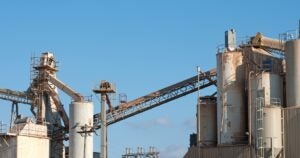
Building a greener future: How federal purchasing power can drive a low-carbon cement industry
This blog was co-authored by Dara Diamond, Federal Climate Innovation Intern
Historic climate investments from the Biden administration have put a much-needed down payment toward cutting emissions from industry — a major economic sector that makes up over a quarter of U.S. emissions. Still, a lot of hard work remains to meaningfully scale up solutions in this sector. A particularly tricky piece of the industrial emissions problem is hidden in plain sight all around us, in our buildings, sidewalks, highways and bridges: cement.
The scale of this climate challenge is colossal. Cement is the most widely used man-made material on the planet. If the cement industry were a country, it would be the third largest emitter in the world.
To slash emissions from cement production, policymakers will need to make the most of existing climate investments and put forward a range of new solutions, including putting the federal government’s massive purchasing power to work.
Here is why cement poses unique climate challenges — and how policymakers can leverage public procurement to help meet them.
Why cement?
When mixed with water and other aggregates like sand and gravel, cement produces concrete — a very resilient and durable material used to build an array of heavy load-bearing infrastructure. The production of cement, however, is also a major source of greenhouse gases (GHG), accounting for 8% of global CO2 emissions.
In the United States, cement production accounts for 67 million metric tons of CO2e in 2019, representing about 10% of the industrial sector’s direct emissions. This industry is difficult to decarbonize because most of these harmful emissions are generated not by the energy source (heat) but by the cement-making process itself.
The chemistry involved in the cement making process is inherently dirty: 51% of emissions come from one key chemical reaction called calcination, which is the process of transforming calcium carbonate (limestone) into calcium oxide (lime) which then reacts with other raw materials to form clinker — a key ingredient in cement.
How can we cut carbon from cement production?
While incremental emissions reductions strategies like energy efficiency will play some role in tackling the climate crisis, developing and deploying innovative solutions to reduce emissions from cement production will be essential to achieve the U.S. goal of net-zero emissions by 2050. And, given the inertia in the cement sector and the long lifetimes of assets, it’s particularly important we start now.
Fortunately, there are policy levers that decision makers can pull to accelerate progress in this sector. These range from supply-side measures like research and development (R&D) funding — many low-carbon technologies in this sector are less mature than those in other sectors — to demand-side measures like government procurement and prizes for innovation.
Bipartisan legislation introduced last year by Senators Chris Coons and Thom Tillis includes a number of these measures to move the market toward clean cement. The Concrete and Asphalt Innovation Act of 2023 would create a research, development and demonstration (RD&D) program; support the development and testing of low-emissions concrete; provide grants for low-emissions transportation materials; and authorize advance purchase commitments for low-emissions concrete and asphalt.
Another lever available to policymakers is the enormous purchasing power of the federal government — over $650 billion annually. Government procurement accounts for approximately 50% of U.S. demand for cement, according to the DOE’s Low Carbon Cement Commercial Liftoff report. This means the public sector has a major role to play in driving the adoption of new technologies and accelerating decarbonization in the cement sector.
Next steps for green public procurement
For green public procurement to work, decision makers need information on how “green” each product is. In the U.S. this is mainly done through Environmental Product Declarations (EPDs), documents that describe the environmental impacts of particular products over their entire life cycle. Policymakers also need to determine emission intensity benchmarks, which set the maximum allowed embodied carbon for products to be eligible under the procurement policy.
In 2021, President Biden announced Executive Order 14057 — the Federal Sustainability Plan — which includes the requirement for net-zero emissions procurement by 2050. This plan included launching a Federal Buy Clean Initiative and creating a Federal Buy Clean Task Force. The initiative is designed to prioritize domestic low-carbon construction materials in federal procurement and federally funded projects. Federal Buy Clean covers steel, cement/concrete, asphalt, and glass. In addition to the federal initiative, green public procurement policies have been implemented on state and local levels in places like New York and Colorado.
Potential challenges to greener procurement
Green procurement may face some challenges. Implementing innovative production technologies and new sustainability practices in a legacy industry like cement requires a shift in mindset and approach across a wide range of stakeholders, which can be met with resistance. Transitioning to greener procurement comes with significant attendant upfront costs for technology, education, and training. There is also a lack of harmonization of standards making it difficult for industry to embrace and implement green procurement policies. Sourcing sustainable substitute raw materials and products can also be challenging due to limited market availability.
Cement producers must be willing to retool existing plants or build new ones. This is a capital-intensive endeavor that would require between $500 million and $1 billion in investments according to the DOE’s Liftoff report. Simply put, there are material risks inherent in a green procurement regime.
Without the appropriate policy push, the cement industry will not embrace the risk. The federal government could encourage producers in the direction of green procurement with a stick, like an emissions tax, or with a carrot of harmonized government procurement. We also need to answer outstanding questions surrounding the feasibility of carbon capture and storage (CCS) application to cement facilities. Questions like: can we lower the energy-intensity of CCS, how will the captured carbon be safely transported and stored, and how do we ensure other harmful emissions beyond CO2 are also addressed? More funds need to be put into research development and demonstration to ensure the safety and durability of low-carbon alternatives and scale up to make them commercially viable.
Benefits of procurement
Despite the potential challenges, implementing green procurement practices in the cement industry offers many advantages. It reduces carbon emissions, lowers energy consumption, provides long-term cost savings, and minimizes the extraction of raw materials from the environment. It could also lead to reduced air and water pollution, protecting natural ecosystems and human health. Adopting green procurement practices could also enhance a company’s reputation and attract environmentally conscious consumers.
Embracing green procurement practices is crucial for slashing harmful pollution from the cement industry, and ultimately driving us closer to our national climate goals. By signaling the demand for low-carbon cement, the U.S can lead the global effort to decarbonize the sector and benefit from the economic, environmental and social advantages of a low-carbon transition.












